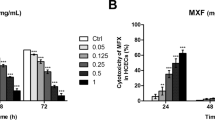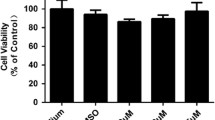Abstract
Background
To investigate genotoxicity of the preservative thimerosal (Thi), and the cytoprotective and antioxidant effects of hyaluronic Acid (HA) and hydroxypropyl methylcellulose (HPMC) on Chang conjunctival cells.
Method
Cells were divided into three groups. One group was exposed to Thi at various concentrations (0.00001 %∼0.001 %) for 30 min; the other two groups were pretreated with 0.3 % HA or 0.3 % HPMC for 30 min before the Thi exposure. After cell viability was evaluated, alkaline comet assay and detection of the phosphorylated form of the histone variant H2AX (γH2AX) foci were used to determine DNA damage. Reactive oxygen species (ROS) production was assessed by the fluorescent probe, 2', 7'-dichlorodihydrofluorescein diacetate (DCFH-DA).
Results
A significant change of cell viability was observed after exposure to 0.001 % Thi for 30 min. DNA single- and double-strand breaks were significantly increased in a dose-dependent manner with Thi exposure. In addition, intracellular ROS induced by Thi was dose-dependent, except at 0.001 % less ROS was induced than at 0.0005 %. However, cells pretreated with 0.3 % HA or 0.3 % HPMC showed significantly increased cell survival, decreased DNA damage, and decreased ROS production compared to cells exposed to Thi alone. Pretreatment with 0.3 % HA was found to be even more protective than 0.3 % HPMC.
Conclusion
Thi can induce DNA damage in human conjunctival epithelial cells, probably due to oxidative stress. HA and HPMC are protective agents that have antioxidant properties and can decrease DNA damage induced by Thi. Pretreatment of 0.3 % HA may be more protective of the ocular surface than 0.3 % HPMC.





Similar content being viewed by others
References
Van Horn DL, Edelhauser HF, Prodanovich G, Eiferman R, Pederson HF (1977) Effect of the ophthalmic preservative thimerosal on rabbit and human corneal endothelium. Invest Ophthalmol Vis Sci 16:273–280
Mondino BJ, Groden LR (1980) Conjunctival hyperemia and corneal infiltrates with chemically disinfected soft contact lenses. Arch Ophthalmol 98:1767–1770
Ferrat L, Romeo M, Gnassia-Barelli M, Pergent-Martini C (2002) Effects of mercury on antioxidant mechanisms in the marine phanerogam Posidonia oceanica. Dis Aquat Organ 50:157–160
Ben-Ozer EY, Rosenspire AJ, McCabe MJ Jr, Worth RG, Kindzelskii AL, Warra NS, Petty HR (2000) Mercuric chloride damages cellular DNA by a non-apoptotic mechanism. Mutat Res 470:19–27
Morgan SE, Kastan MB (1997) p53 and ATM: cell cycle, cell death, and cancer. Adv Cancer Res 71:1–25
Moll UM, Slade N (2004) p63 and p73: roles in development and tumor formation. Mol Cancer Res 2:371–386
Aragona P, Di SG, Ferreri F, Spinella R, Stilo A (2002) Sodium hyaluronate eye drops of different osmolarity for the treatment of dry eye in Sjogren's syndrome patients. Br J Ophthalmol 86:879–884
Aragona P, Papa V, Micali A, Santocono M, Milazzo G (2002) Long term treatment with sodium hyaluronate-containing artificial tears reduces ocular surface damage in patients with dry eye. Br J Ophthalmol 86:181–184
Johnson ME, Murphy PJ, Boulton M (2006) Effectiveness of sodium hyaluronate eyedrops in the treatment of dry eye. Graefes Arch Clin Exp Ophthalmol 244:109–112
Toda I, Shinozaki N, Tsubota K (1996) Hydroxypropyl methylcellulose for the treatment of severe dry eye associated with Sjogren's syndrome. Cornea 15:120–128
Urtti A (2006) Challenges and obstacles of ocular pharmacokinetics and drug delivery. Adv Drug Deliv Rev 58:1131–1135
Singh NP, McCoy MT, Tice RR, Schneider EL (1988) A simple technique for quantitation of low levels of DNA damage in individual cells. Exp Cell Res 175:184–191
Zhou C, Li Z, Diao H, Yu Y, Zhu W, Dai Y, Chen FF, Yang J (2006) DNA damage evaluated by gammaH2AX foci formation by a selective group of chemical/physical stressors. Mutat Res 604:8–18
Sasaki H, Igarashi Y, Nagano T, Nishida K, Nakamura J (1995) Different effects of absorption promoters on corneal and conjunctival penetration of ophthalmic beta-blockers. Pharm Res 12:1146–1150
Kumaravel TS, Jha AN (2006) Reliable Comet assay measurements for detecting DNA damage induced by ionising radiation and chemicals. Mutat Res 605:7–16
Redon C, Pilch D, Rogakou E, Sedelnikova O, Newrock K, Bonner W (2002) Histone H2A variants H2AX and H2AZ. Curr Opin Genet Dev 12:162–169
Fernandez-Capetillo O, Lee A, Nussenzweig M, Nussenzweig A (2004) H2AX: the histone guardian of the genome. DNA Repair (Amst) 3:959–967
Sedelnikova OA, Rogakou EP, Panyutin IG, Bonner WM (2002) Quantitative detection of (125)IdU-induced DNA double-strand breaks with gamma-H2AX antibody. Radiat Res 158:486–492
Schein OD, Hibberd PL, Starck T, Baker AS, Kenyon KR (1992) Microbial contamination of in-use ocular medications. Arch Ophthalmol 110:82–85
Fuerst DJ, Sugar J, Worobec S (1983) Superior limbic keratoconjunctivitis associated with cosmetic soft contact lens wear. Arch Ophthalmol 101:1214–1216
Whittington CV (1985) Elicitation of contact lens allergy to thimerosal by eye cream. Contact Dermatitis 13:186
Zadnik K (1984) Severe allergic reaction to saline preserved with thimerosal. J Am Optom Assoc 55:507–509
Coward BD, Neumann R, Callender M (1984) Solution intolerance among users of four chemical soft lens care regimens. Am J Optom Physiol Opt 61:523–527
Mondino BJ, Brawman-Mintzer O, Boothe WA (1987) Immunological complications of soft contact lenses. J Am Optom Assoc 58:832–835
Wilson LA, McNatt J, Reitschel R (1981) Delayed hypersensitivity to thimerosal in soft contact lens wearers. Ophthalmology 88:804–809
Shulman IA, Hasz LA, Simpson RB (1982) Thimerosal dependent agglutination, a newly described blood bank problem. Transfusion 22:241–243
Shulman IA, Simpson RB, Farmer CF, Lam HT (1984) Thimerosal-dependent agglutination complicating the serologic evaluation for unexpected antibodies. Transfusion 24:365–367
Shenker BJ, Guo TL, O I, Shapiro IM (1999) Induction of apoptosis in human T-cells by methyl mercury: temporal relationship between mitochondrial dysfunction and loss of reductive reserve. Toxicol Appl Pharmacol 157:23-35
Ariza ME, Holliday J, Williams MV (1994) Mutagenic effect of mercury (II) in eukaryotic cells. In Vivo 8:559–563
Hamilton-Koch W, Snyder RD, Lavelle JM (1986) Metal-induced DNA damage and repair in human diploid fibroblasts and Chinese hamster ovary cells. Chem Biol Interact 59:17–28
McKelvey-Martin VJ, Green MH, Schmezer P, Pool-Zobel BL, De Meo MP, Collins A (1993) The single cell gel electrophoresis assay (comet assay): a European review. Mutat Res 288:47–63
Fernandez-Capetillo O, Celeste A, Nussenzweig A (2003) Focusing on foci: H2AX and the recruitment of DNA-damage response factors. Cell Cycle 2:426–427
Fernandez-Capetillo O, Chen HT, Celeste A, Ward I, Romanienko PJ, Morales JC, Naka K, Xia Z, Camerini-Otero RD, Motoyama N, Carpenter PB, Bonner WM, Chen J, Nussenzweig A (2002) DNA damage-induced G2-M checkpoint activation by histone H2AX and 53BP1. Nat Cell Biol 4:993–997
Devasagayam TP, Tilak JC, Boloor KK, Sane KS, Ghaskadbi SS, Lele RD (2004) Free radicals and antioxidants in human health: current status and future prospects. J Assoc Physicians India 52:794–804
Cooke MS, Evans MD, Dizdaroglu M, Lunec J (2003) Oxidative DNA damage: mechanisms, mutation, and disease. FASEB J 17:1195–1214
Clarkson TW, Magos L (2006) The toxicology of mercury and its chemical compounds. Crit Rev Toxicol 36:609–662
Migdal C, Foggia L, Tailhardat M, Courtellemont P, Haftek M, Serres M (2010) Sensitization effect of thimerosal is mediated in vitro via reactive oxygen species and calcium signaling. Toxicology 274:1–9
Barzilai A, Yamamoto K (2004) DNA damage responses to oxidative stress. DNA Repair (Amst) 3:1109–1115
Pisella PJ, Fillacier K, Elena PP, Debbasch C, Baudouin C (2000) Comparison of the effects of preserved and unpreserved formulations of timolol on the ocular surface of albino rabbits. Ophthalmic Res 32:3–8
Kim SW, Bae YH, Okano T (1992) Hydrogels: swelling, drug loading, and release. Pharm Res 9:283–290
Leibowitz HM, Chang RK, Mandell AI (1984) Gel tears. A new medication for the treatment of dry eyes. Ophthalmology 91:1199–1204
Pape LG, Balazs EA (1980) The use of sodium hyaluronate (Healon) in human anterior segment surgery. Ophthalmology 87:699–705
DeLuise VP, Peterson WS (1984) The use of topical Healon tears in the management of refractory dry-eye syndrome. Ann Ophthalmol 16:823–824
Stuart JC, Linn JG (1985) Dilute sodium hyaluronate (Healon) in the treatment of ocular surface disorders. Ann Ophthalmol 17:190–192
Gill GW, Frost JK, Miller KA (1974) A new formula for a half-oxidized hematoxylin solution that neither overstains nor requires differentiation. Acta Cytol 18:300–311
Papa V, Aragona P, Russo S, Di BA, Russo P, Milazzo G (2001) Comparison of hypotonic and isotonic solutions containing sodium hyaluronate on the symptomatic treatment of dry eye patients. Ophthalmologica 215:124–127
Pauloin T, Dutot M, Warnet JM, Rat P (2008) In vitro modulation of preservative toxicity: high molecular weight hyaluronan decreases apoptosis and oxidative stress induced by benzalkonium chloride. Eur J Pharm Sci 34:263–273
Augustin AJ, Dick HB (2004) Oxidative tissue damage after phacoemulsification: influence of ophthalmic viscosurgical devices. J Cataract Refract Surg 30:424–427
Acknowledgements
The work was supported by project foundation : 1.Zhejiang province Key Innovation Team Project of China (No.2009R50039) 2.Zhejiang Key Laboratory Fund of China (No.2011E10006) 3. Natural Science Foundation of China (30973270) 4. The Natural Science Foundation of China (81070756) 5. National “Twelfth Five-Year” Plan for Science & Technology Support of China (2012BAI08B01).
Author information
Authors and Affiliations
Corresponding author
Additional information
The authors have no financial interest in any product or concept discussed in article.
Rights and permissions
About this article
Cite this article
Ye, J., Zhang, H., Wu, H. et al. Cytoprotective effect of hyaluronic acid and hydroxypropyl methylcellulose against DNA damage induced by thimerosal in Chang conjunctival cells. Graefes Arch Clin Exp Ophthalmol 250, 1459–1466 (2012). https://doi.org/10.1007/s00417-012-2087-4
Received:
Revised:
Accepted:
Published:
Issue Date:
DOI: https://doi.org/10.1007/s00417-012-2087-4




